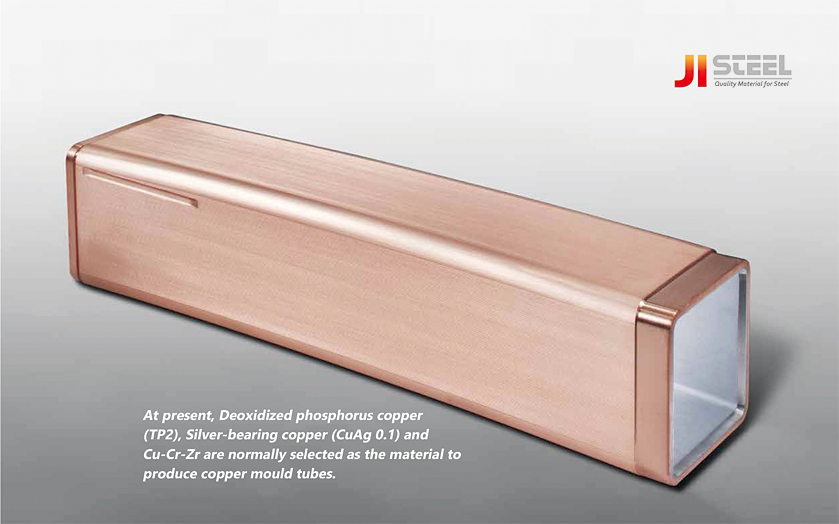News
2021 / 10 / 21
The Function and Design of Continuous Casting Copper Mould Tube?
The main function of the copper tube of the continuous casting mold is to provide rapid and uniform cooling of the molten steel, promote the rapid and uniform growth of the billet shell, and form a billet shell with good quality. Under the action of mechanical stress and thermal stress, it will not be broken or broken. Quality defects such as distortion and cracks will not occur. Therefore, controlling and improving the heat transfer effect of the mold is an important part of continuous casting process control.

After the molten steel enters the mold, solidification and shrinkage occur, and an air gap of a certain thickness will inevitably appear between the shell and the mold, resulting in a decrease in the heat transfer capacity of the mold. The thermal resistance of the air gap accounts for 80% of the sum of the thermal resistances in the mold. In order to eliminate or reduce the air gap, the cavity of the mold should be designed to have a certain reverse taper, and the cavity of the continuous taper mold can better reduce the thickness of the air gap and better meet the technological requirements of high-speed continuous casting. The size of the taper affects the formation of the homogeneous billet shell. If the taper is too large, a large friction force will be generated when the billet is drawn, resulting in leakage; if the taper is too small, the compensation for the shrinkage of the billet shell will be weakened, and the gap between the billet shell and the copper tube will be too large. Conducive to shell growth. The taper of the copper tube should make the billet shell grow evenly and quickly, with a long service life, and at the same time adapt to a wide range of pouring speed and meet the pulling speed requirements of the continuous casting machine in colleges and universities. The heat flow of a single-taper crystallizer decreases continuously along the length of the crystallizer. Except for the first section of about 100mm, the heat flow of the parabolic mold is basically unchanged in the rest of the length. Therefore, the mold is designed to have a parabolic reverse taper, which is large at the top and small at the bottom, to compensate for the shrinkage of the casting billet during the crystallization period, reduce the thermal resistance of the air gap, and significantly increase the billet drawing speed.
The design of the inverted taper and the selection of the shape of the mold cavity should follow the following technical principles, that is, strictly obey the solidification shrinkage characteristics of the steel grade, so that the shape of the mold taper cavity is maximally suitable for the actual shape of the solidified shell in the mold, so that the The thickness of the air gap in the entire mold is reduced to a minimum, thereby improving the heat transfer effect of the mold, so as to ensure the uniformity of the thickness of the shell in the mold and the thickness of the shell at the bottom of the mold.
The shrinkage of the mold from top to bottom should be equal to the total shrinkage caused by the shrinkage of the molten steel during the solidification process and the solid state shrinkage after solidification. Shrinkage, the following assumptions can be made when calculating the copper tube of the billet continuous casting mold:
(1) The density of the billet shell in the mold and the density of the molten steel can be considered to be approximately equal
(2) The influence of air gap and mold slag is not considered
(3) The shrinkage of molten steel in the mold is linear shrinkage, ignoring the influence of the inner angle of the mold and the build-up flow
(4) Ignore the shrinkage caused by the decrease of the shell temperature
(5) Ignore the liquid shrinkage of molten steel
Contact Us
Address
High-tech Industrial Development Zone, Zhengzhou City, Henan Province, China.
jean@ji-steel.com
Phone
+86 188 3804 2177
Products
- Continuous Casting
- ● Copper Mould Tube
- ● Mould Assembly
- Steel Melting
- ● Graphite Electrode
- Refractory Material
- ● Nozzle Bricks
- ● Magnesia Carbon Brick
- ● High Alumina Brick
Contact
- jean@ji-steel.com
- +86 371 6781 0168
- +86 188 3804 2177
- +86 188 3804 2177
- www.ji-steel.com
- High-tech Industrial Development Zone, Zhengzhou City, Henan Province, China.
Quick Links
© Copyright 2022 JI Steel. All right reserved.